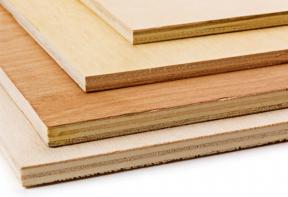Working with plywood
Of course, marrying fine design with inexpensive building materials is nothing new. Not every project requires exotic woods. Sometimes, as master builder Hendrik Varju points out, plywood does the job.
Working with solid wood is a joy in so many ways. When you see a minor defect, you have material thickness to sand, scrape and plane. But for larger case goods, such as cabinetry and bookcases, solid wood isn’t always practical. Covering large expanses with solid lumber that has to be milled, edge-glued and planed can be very time-consuming and cumbersome. Sometimes quality, veneered sheet goods are the best option.
Choosing plywood
Sheet goods come in a wide variety of grades and surface types. Particleboard-core stock is less expensive, but has a number of disadvantages, such as excessive weight, less holding power for screws and higher glue content, which dulls tools faster. MDF-core stock is sometimes available, which is even heavier but very flat. My preference is veneer-core stock, which is made of alternating layers of less expensive wood, such as poplar. It holds screws well for hinges or other hardware, and it is much lighter than particleboard- and MDF-core stock.
Ripping plywood
Some special techniques are necessary to rip plywood. While I normally use a rip blade for solid wood, it doesn’t cut veneer-core plywood quite as well. Because every other layer in the core is actually a cross cut, a rip blade makes a ragged cut in those layers, preventing edging from adhering as tightly. A combination blade does the best job; it is the best compromise when you need to both rip and cross cut simultaneously.
Remember that you can’t use your jointer and planer with plywood, and that includes straightening edges before applying edging. MDF and particleboard cores will ruin your jointer knives in a hurry. Veneer-core stock will chip the knives on every end-grain layer, leaving a striped knife pattern on all your solid-wood stock afterward. Jointer and planer knives do not like end-grain.
Having to get a near-perfect edge straight off a tablesaw is a tall order. But your best approach is to use a long auxiliary fence. Then choose an already straight or slightly concave edge to place against the fence to true up the opposite edge. As long as the fence is long enough, two points of a concave edge will make contact with the fence and still provide a straight travel path.
Travel at a reasonable speed without stopping or any hesitation, and an accurate edge is possible. Don’t forget the importance of a properly set splitter, both for accuracy and safety.
Jump to a section
- Page 1 : Choosing and ripping plywood
- Page 2 : Solid-wood edging
- Page 3 : Cutting dados
- Page 4 : Cross-cutting and edge banding
- Page 5 : Trimming edging materials
To leave a comment, please log in












No comments